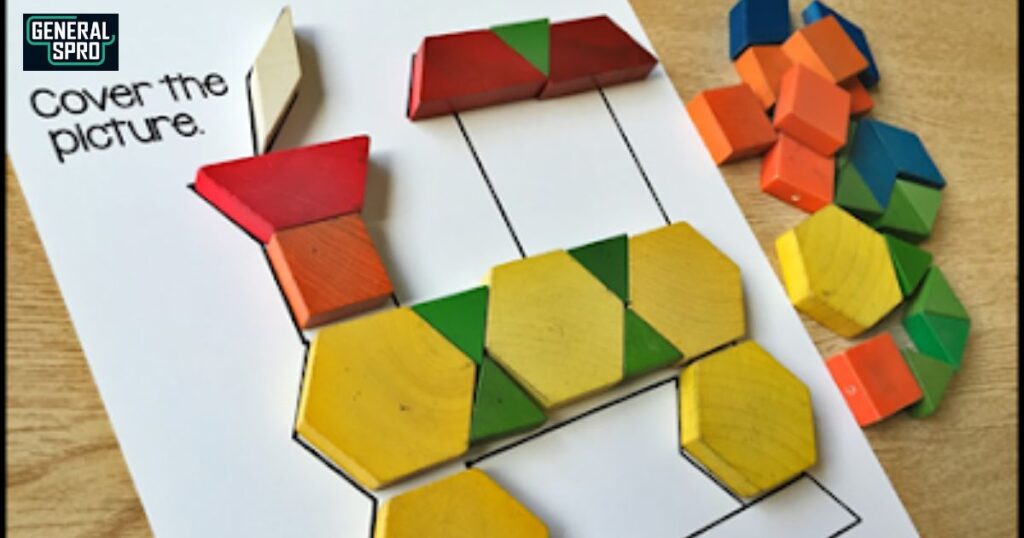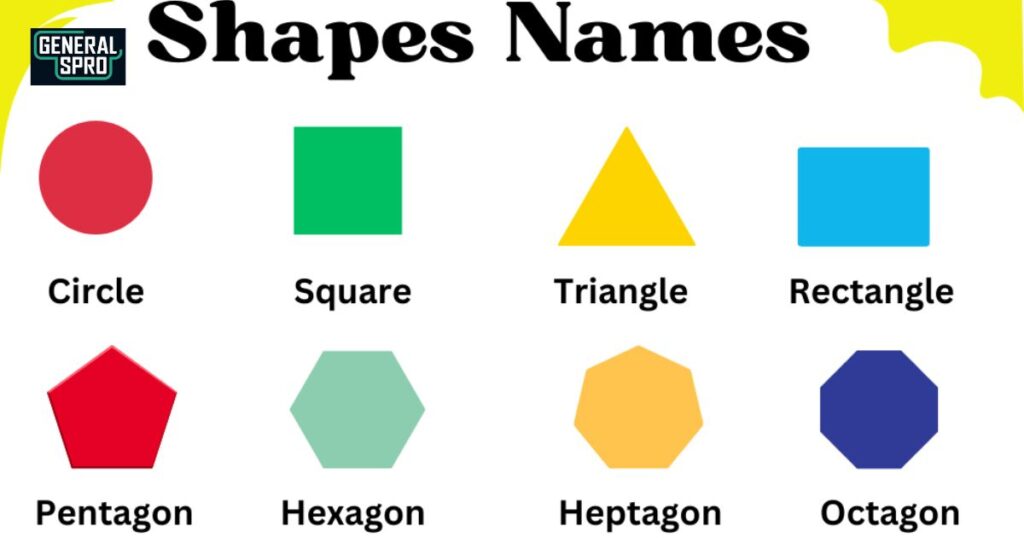Are you looking to master the fundamentals of geometric shapes? Whether you’re a student diving into mathematics, a teacher developing lesson plans, or someone curious about the building blocks of our visual world, this comprehensive guide covers everything you need to know about shapes and their characteristics.
From basic 2D figures to complex 3D structures, we’ll explore the fascinating world of geometric shapes with clear explanations and practical examples.
Types of Shapes: Understanding the Basics
Shapes form the foundation of geometry and play a crucial role in how we perceive and interact with the world. At their most basic level, shapes fall into two main categories:
two-dimensional (2D) and three-dimensional (3D).
Two-dimensional shapes exist on a flat surface with length and width, while three-dimensional shapes add depth to create objects with volume.
Understanding geometric shapes isn’t just about memorizing names and properties – it’s about recognizing patterns and relationships throughout nature, architecture, and design.
Let’s explore these fundamental building blocks of geometry, starting with the simplest 2D shapes and progressing to more complex 3D structures.
Two-Dimensional Shapes: The Building Blocks of Geometry

Two-dimensional shapes serve as the foundation for more complex geometric concepts. These flat shapes, also known as plane figures, exist in a space defined by two dimensions: length and width. Let’s examine each fundamental 2D shape in detail.
Circle
The circle is one of the most perfect and symmetrical geometric shapes. A circle is a set of points in a plane all the same distance from a central point. This distance is called the radius, while the line that runs through the center and touches both sides is the diameter.
Key Properties of Circles:
- Radius (r): The distance from the center to any point on the circle
- Diameter (d): Twice the radius (d = 2r)
- Circumference (C): The distance around the circle (C = 2πr)
- Area (A): The space inside the circle (A = πr²)
Typical applications of circles include:
- Wheels and gears in machinery
- Clock faces and timing devices
- Plates, cups, and cylindrical containers
- Satellite dishes and radio antennas
- Maintenance hole covers (which can’t fall through their openings)
Square
The square represents perfect symmetry in four-sided shapes. As a regular quadrilateral, all its sides have equal lengths, and all its angles measure precisely 90 degrees. This makes the square a fundamental construction, design, and mathematics shape.
Key Properties of Squares:
- Four equal sides
- Four right angles (90 degrees)
- Parallel opposite sides
- Two equal diagonals that bisect each other
- Area = side length²
Essential Geometry: A Foundation for Understanding Shapes
Geometry forms the bedrock of our understanding of the physical world. From ancient civilizations to modern engineering, geometric principles help us describe, measure, and manipulate space.
These fundamental concepts transcend mathematical theory, influencing everything from art and architecture to technology and natural sciences.
Shapes in Architecture: From Ancient Pyramids to Modern Skyscrapers
Throughout history, architects have harnessed the power of geometric shapes to create stunning structures.
The ancient Egyptians used precise triangular formations to build the pyramids, while contemporary architects employed complex geometric patterns in revolutionary designs.
Modern buildings often combine multiple shapes to achieve aesthetic appeal and structural integrity.
The Mathematics Behind Shape Properties
Understanding the mathematical properties of shapes reveals their true elegance. Each shape possesses unique characteristics that can be expressed through formulas and equations.
These properties don’t just exist in textbooks – they’re crucial for engineering, construction, and countless practical applications.
Sacred Geometry: Shapes in Nature and Religious Architecture
Sacred geometry explores the profound relationship between shapes and spiritual significance.
From the Fibonacci spiral found in nautilus shells to the intricate geometric patterns in mosque architecture, these mathematical principles appear consistently in both natural phenomena and human-made structures.
Teaching Shapes to Young Minds: Educational Approaches
Introducing shapes to children requires thoughtful pedagogy. Effective teaching methods combine visual learning with hands-on activities, helping young learners grasp spatial relationships and geometric concepts. Interactive tools and real-world examples make shape recognition both engaging and memorable.
Digital Design: The Role of Shapes in User Interface

In the digital age, shapes are crucial in user interface design. From app icons to website layouts, geometric principles guide how we interact with technology.
Understanding shape psychology helps designers create intuitive and visually appealing digital experiences.
The Psychology of Shapes: Impact on Human Perception
Shapes profoundly influence how we perceive and interact with our environment. Different shapes evoke distinct emotional responses and psychological associations.
This understanding proves invaluable in fields ranging from marketing to therapeutic environment design.
Industrial Applications of Geometric Principles
Manufacturing and industrial design rely heavily on geometric precision. From packaging design to machine components, understanding shape properties ensures efficient production and functional products.
Modern manufacturing techniques like 3D printing have revolutionized how we create complex geometric forms.
Shapes in Art History: From Renaissance to Modern Art
Throughout history, artists have used geometric shapes as fundamental elements of composition. The Renaissance brought perspective and proportion, while modern art movements like Cubism deconstructed and reimagined traditional forms.
Understanding this evolution provides insight into artistic expression across centuries.
Innovative Shape Applications in Modern Technology
Contemporary technology increasingly relies on sophisticated geometric principles. From satellite design to nanotechnology, precise shape engineering enables breakthrough innovations.
The intersection of geometry and technology continues to push boundaries in various fields.
Environmental Design: Shapes in Landscape Architecture
Landscape architects strategically use shapes to create harmonious outdoor spaces. Natural and geometric forms combine to produce functional and aesthetically pleasing environments.
Understanding shape relationships helps build sustainable and engaging landscapes.
The Role of Shapes in Brand Identity and Logo Design
Corporate identities often rely on distinctive geometric shapes. Logo design utilizes shape psychology to convey brand values and create memorable visual identities.
Simple geometric forms can communicate complex brand messages effectively.
Shapes in Scientific Research and Discovery
Scientific research often reveals fascinating geometric patterns in nature. From crystalline structures to cellular arrangements, shapes help us understand natural phenomena.
Geometric principles guide research in fields from astronomy to molecular biology.
Future Trends: Emerging Applications of Geometry

As technology advances, new applications for geometric principles continue to emerge. From quantum computing to biotechnology, understanding shapes remains crucial for innovation.
Future developments promise even more sophisticated uses of geometric principles.
Cross-Cultural Perspectives on Geometric Forms
Different cultures interpret and use geometric shapes in unique ways. From Islamic geometric patterns to Native American symbols, shapes carry diverse cultural meanings.
Understanding these perspectives enriches our appreciation of geometric diversity in human expression.
FAQ’s
What’s the main difference between 2D and 3D shapes?
2D shapes exist on a flat plane with length and width, while 3D shapes add depth as a third dimension. Think of the difference between a drawing of a square and a physical cube you can hold.
How do you calculate the area of irregular shapes?
Irregular shapes can be broken down into smaller, regular shapes whose areas can be calculated separately. Adding these individual areas together gives you the total area of the irregular shape.
Why are hexagonal shapes so common in nature?
Hexagons provide the most efficient way to fill a space with the least amount of material, which is why bees use them for honeycomb structures. This shape also provides exceptional structural stability.
What makes a shape “regular” versus “irregular”?
Regular shapes have equal sides and angles throughout their structure, like a perfect square or equilateral triangle. Irregular shapes have varying side lengths or angles.
Can all 3D shapes be “unfolded” into 2D shapes?
Yes, all 3D shapes can be unfolded into a “net” – a flat pattern that, when appropriately folded, creates the 3D shape. This concept is crucial in packaging design and manufacturing.
What’s the relationship between circles and spheres?
A sphere is an infinite number of circles stacked in three dimensions. Every cross-section of a sphere is a perfect circle, making it one of the most symmetrical 3D shapes.
How do architects use geometric shapes in building design?
Architects combine basic geometric shapes to create structurally sound and aesthetically pleasing buildings. They consider both the visual impact and practical functions of different shapes.
Why are triangles considered the most muscular shape in construction?
Triangles are inherently stable because they can’t be deformed without changing the length of their sides. This makes them crucial in construction, especially for roof trusses and bridge designs.
Conclusion
Geometric shapes represent far more than just mathematical concepts – they’re the fundamental building blocks of our visual world.
From the precise engineering of modern architecture to the delicate patterns found in nature, shapes communicate a universal language that transcends cultural and linguistic boundaries.
As we’ve explored in this comprehensive guide, understanding shapes empowers us to better appreciate the world around us and solve complex problems in fields ranging from education to advanced technology.
Whether you’re a student mastering basic geometry, a professional applying these principles in your work, or simply someone curious about the mathematical beauty of our universe, the study of shapes offers endless opportunities for discovery and innovation.








